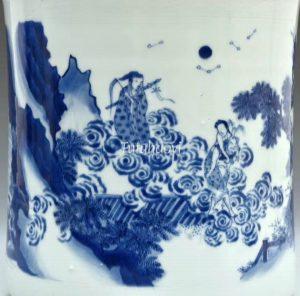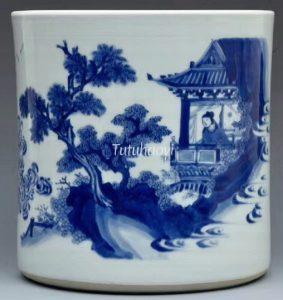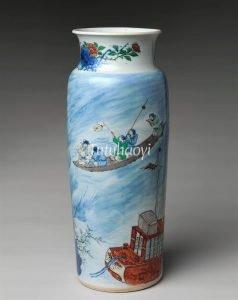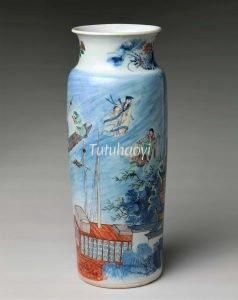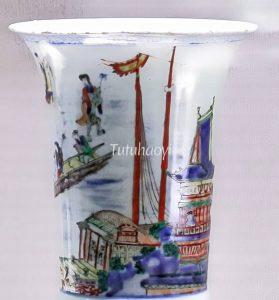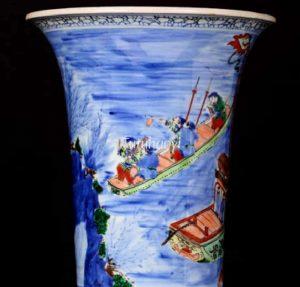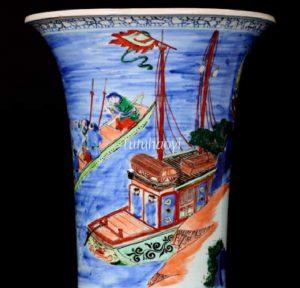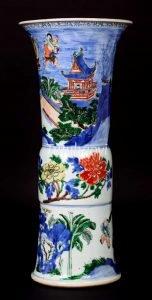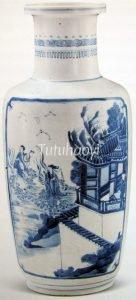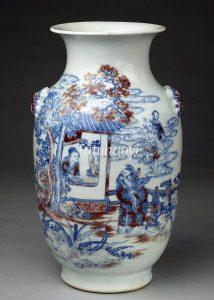Lv Dongbin Sending Liang Hao a Bride to Repay him a Life Debt
青袍记 (吕翁报恩送新娘)
© Tutuhaoyi.com owns the copyright of the description content for the images attached. Quoting all or part of the description content on this page is permitted ONLY IF ‘Tutuhaoyi.com’ is clearly acknowledged anywhere your quote is produced unless stated otherwise. (本页描述内容版权归Tutuhaoyi.com所有,转发或引用需注明 “Tutuhaoyi.com”, 侵权必究, 已注开源信息的条目除外。)
The Ming-dynasty play The Story of the Blue Robe (青袍记 Qingpao ji, also called《梁氏父子传胪记》) tells the story of how Lv Dongbin (吕洞宾 Lü Dongbin or 吕纯阳), one of the Eight Daoist Immortals (八仙 baxian), survived a catastrophe with the help of Liang Hao 梁灏 and repaid him by ensuring him to be able to enjoy the highest academic title, longevity, and a flourishing extended family.
A scholar named Liang Hao in Song dynasty was the human form taken by the God of Literacy when he was disgraced to be sent to the human world. Once the Thunder God and Lightning Goddess were ordered to cleanse the earth with seven days of thunderstorm. This was the ordeal which Lv Dongbin, Liu Hai 刘海, Iron-Crutch Li 铁拐李, Han Shan 寒山, and Shi De 拾得 were all predestined to go through. Liang Hao helped Lv Dongbin by letting him hide in his fingernail as a grain. After Lv Dongbin survived the disaster, he decided to repay Liang Hao by leaving him with his good wishes for a successful career, longevity, and many successful descendants.
The next day, Liang Hao invited his three friends over and dined and wined them on a boat. Towards the evening, two of the friends said that they heard that there was a spirit in the Pavilion of Looking at Immortals (望仙楼) and whoever spent a night there would come under its spell. They dared Liang Hao to spend the night there for a reward of a tael of silver. Liang Hao took up the challenge and stayed in the pavilion reading by a lamp. Lv Dongbin thought that this was an opportunity and mobilised a willow-tree spirit (柳树精 liushu jing) to carry a girl to Liang to be his future wife. Since the girl was taken from her bed and arrived naked, Liang Hao had to wrap her in his blue robe, hence the title of the play. Liang Hao sent the girl to spend the night with his mother and the following day the girl’s parents were informed of the event and happily married their daughter to Liang Hao.
image identification and literature research by Dr Yibin Ni
Fig 1-2: porcelain brush holder with underglaze blue decoration, Chongzhen period (1628–44), Ming dynasty, courtesy of Sotheby’s auction house
Fig 3: porcelain jar with underglaze blue and overglaze enamelled decoration, Shunzhi period (1644–61), Qing dynasty, courtesy of the Sir Michael Butler Collection
Fig 4: porcelain square vase with overglaze enamelled decoration (detail of a side), Shunzhi period (1644–61), Qing dynasty, courtesy of the Sir Michael Butler Collection
Fig 5-6: porcelain rolwagen vase with underglaze blue and overglaze enamelled decoration, Shunzhi period (1644–61), Qing dynasty, courtesy of the Metropolitan Museum of Art, New York
Fig 7-8: beaker vase with underglaze blue and overglaze enamelled decoration, Shunzhi period (1644–61), Qing dynasty, courtesy of China Ceramic Museum, Jingdezhen, Jiangxi, China
Fig 9-12: beaker vase with underglaze blue and overglaze enamelled decoration, Shunzhi period (1644–61), Qing dynasty, courtesy of Ashmolean Museum, University of Oxford, Accession no. EA1978.1903
Fig 13: porcelain rolwagen vase with underglaze blue and overglaze enamelled decoration, Shunzhi period (1644–61), Qing dynasty, courtesy of Boijmans-van Beuningen Museum
Fig 14: porcelain vase with underglaze blue decoration, Kangxi period (1662–1722), Qing dynasty, courtesy of Tianjin Art Museum
Fig 15: square porcelain plaque with underglaze blue decoration, Kangxi period (1662–1722), Qing dynasty, courtesy of Christie’s auction house
Fig 16: porcelain dish with overglaze enamelled decoration, Kangxi period (1662–1722), Qing dynasty, courtesy of the Victoria & Albert Museum, London
Fig 17: porcelain vase with underglaze blue and red decoration, 19th century, courtesy of the Victoria & Albert Museum, London
